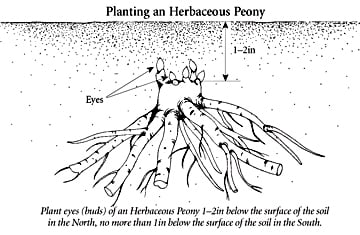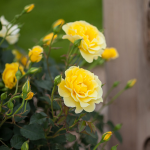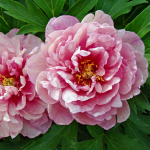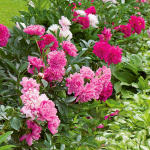Product Details
Don’t let the tongue-twister name hinder you from getting to know this incredible Itoh Peony. ‘Scrumdidleumptious’ tosses up finely formed, semi-double to double blossoms (averaging 6” across) of soft creamy yellow suffused with pink that darkens slightly at the edges of the petals to form a subtle outline. Thanks to an additional one or two lateral buds per stem, plants are extremely floriferous and have an extended period of bloom. The gently fragrant flowers are displayed just above and beyond the dark green, disease-resistant foliage, making them superior landscape plants with upright or slightly arching stems that do not require staking. Introduced in 2002. Midseason.
The genus Paeonia includes more than 30 species with plants native to Europe, Asia, and western North America. The majority are perennials that die back year to year (Herbaceous Peonies), while some are woody shrubs (Tree Peonies). There is also a group of hybrids created by crossing Herbaceous and Tree Peonies (Itoh/Intersectional Peonies). Peonies flower in mid- and/or late spring with blossoms appearing in a variety of forms, from delicate Singles to petal-packed Doubles. These long-lived, carefree plants are classic elements of borders and beds. They combine beautifully with a wide array of perennials. When Peony blossoms subside, their cut-leaf foliage and mounding forms continue to bring beauty and structure to the garden while flattering and supporting neighboring plants. The flowers of Herbaceous and Itoh Peonies are outstanding in bouquets.
In 1948, Japanese Peony grower Toichi Itoh made the first successful cross between an Herbaceous Peony and a Tree Peony, and the result, christened in his honor, are Itoh (or Intersectional) Peonies. Itohs borrow highly desirable traits from both plant parents then add a few advantageous characteristics of their own. Itohs are available in a broad range of flower forms and colors, including some of the brightest yellows. Plants offer the longest blooming season among all Peonies (about 3-4 weeks). The pointy, divided foliage resembles that of a Tree Peony, yet the blooming period tends to coincide with or slightly precede that of Herbaceous Peonies. The stiff stems tolerate weather and rarely flop, giving plants a full, shrubby look that is consistently tidy in the landscape. At season’s end, plants die back to the ground in the manner of Herbaceous Peonies. And like both parents, these long-lived plants require minimal care. Itohs are a remarkable treasure in any garden and an excellent source of cut flowers. Best grown with a minimum of 6 hours of sunlight.
For more information on growing Peonies, click Growing Guide.
Shipping
HOW PLANTS ARE SHIPPED
The size of the plants we ship has been selected to reduce the shock of transplanting. For some, this means a large, bareroot crown. Others cannot travel bareroot or transplant best if grown in containers. We ship these perennials and annuals in 1 pint pots, except as noted. We must point out that many perennials will not bloom the first year after planting, but will the following year, amply rewarding your patience. We ship bulbs as dormant, bare bulbs, sometimes with some wood shavings or moss. Shrubs, Roses, vines, and other woody plants may be shipped bareroot or in pots. The size of the pot is noted in the quick facts for each item.
WHEN WE SHIP
We ship our bulbs and plants at the right time for planting in your area, except as noted, with orders dispatched on a first-come, first-served basis by climate zone. We also ship a wide range of containers and planters, tools, supplies, fertilizers, garden wear, garden decor items, as well as indoor decorations like wreaths and dried bouquets when available. Estimated dates for shipping are indicated in the green Shipping Details box for each item. Please supply a street address for delivery. Kindly contact us with two weeks notice, if you'll be away at the expected time of delivery.
OUR GUARANTEE
We guarantee to ship plants that are in prime condition for growing. If your order is damaged or fails to meet your expectations, we will cheerfully replace or refund it. Please contact our Customer Service Department at 1-800-503-9624 or email us at [email protected]. Please include your order number or customer number when contacting us.
Reviews
Average Customer Rating:
 (7 Reviews)
Write a Review
(7 Reviews)
Write a Review
Sort by:
Beautiful Scrumdidleumptious Itoh 
A viewer from Gaithersburg, MD/Zone 6
1 of 1 people found this review helpful. Do you? yes no Certified buyer
Scrumdidleumptious 
Jill Cortada from Greensboro, GA
Stunning Peony 
A viewer from Chicago, IL
strong and each year the blooms are doubling! I love buying plants from WFF! This is definitely one to have in your collection of peonies!
3 of 3 people found this review helpful. Do you? yes no Certified buyer
Growing guide

No garden is complete without these imposing plants, which are covered with sumptuous flowers in May and June. True perennials, Herbaceous Peonies may live for fifty years or so, becoming more impressive over time. Peonies are easy to grow and will reward you with armfuls of cut flowers and a splendid show in the garden. They make striking specimen plants, play nicely with other perennials in the garden, and are ideal for bordering a walk or driveway. Early-, mid- and late-blooming varieties are available to extend the flowering season, some of which are fragrant. Peonies are grown in Zones 3 to 8; in the South, they will flower in Alabama but the limit appears to be cooler areas of Zone 8. Southern gardeners should choose early-flowering singles for the best success.
Pronunciation: pay-oh'-nee-ah
Light/Watering: Plant Herbaceous Peonies in full sun except in the South and the warmest parts of the West, where afternoon shade is appreciated and will help the flowers last longer on the plant. An inch of water a week throughout the growing season is recommended.
Fertilizer/Soil and pH: Well-drained soil rich in organic matter is desirable. If your soil is extremely acid, add a few handfuls of calcitic lime at planting time. Plant the roots with the eyes (the pink or white buds at the top of the roots) pointing up and cover with one to two inches of soil in the North and no more than one inch in the South. (Please note: If the eyes are set deeper than recommended, plants may not bloom. For this reason, do not mulch over the crowns.) Don't be surprised if there are few or no flowers the first spring after planting; plants generally take a few years to settle in and bloom heavily. Peonies respond well to an annual sidedressing of one inch of compost or aged manure; no other fertilization is necessary. Many Peonies, certainly the double-flowered varieties, must be staked to prevent a thunderstorm from pushing their blooms into the mud. Set the supports in place as new growth begins to emerge in early spring.
Pests/Diseases: Few insect pests bother Herbaceous Peonies, but a fungal disease called botrytis may be a problem, especially in very wet seasons. The stems of Peonies develop cankers or blacken at the base and fall over or simply wilt. Leaves may show black or brown patches and buds may turn brown and fail to open. Good culture and sanitation in the garden can help prevent or correct these problems. Plants need good drainage and air circulation, so do not crowd. Remove any affected foliage at the first sign of disease and deadhead religiously, removing all flower parts and petals from the garden. Cut off all foliage just below soil level after a killing frost in the fall and remove it and any debris from the area -- do not compost. If botrytis was present the previous spring, add a shallow layer of sand around the plants and crowns and spray newly emerging shoots with Bordeaux mix or lime sulfur following label directions. Fungal spores overwinter at the base of the plants, and spring rains then splash the spores up onto the new shoots. Removing any debris and old foliage and covering the soil with sand helps prevent reinfection.
Another blight known as phytophthora may also appear, but the two diseases are hard to tell apart. Take a sample to your USDA Cooperative Extension Service agent or a specialist if you suspect phytophthora, as this disease is usually fatal to the plant and infected plants should be dug up and destroyed, and the soil replaced before replanting.
Peonies can be susceptible to powdery mildew in summer. The white, powdery mildew fungus covers the leaves to varying degrees, but seems to have little effect on the vigor of the plant. This can be avoided or diminished by planting in full sun and providing ample air circulation around the plants.
Companions: Peonies flower with Roses and Clematis and are lovely with many other perennials; be sure to leave room around the plants for air circulation. White-flowered Peonies are entrancing against a background of evergreens. Spring-flowering bulbs such as Crocus vernus or Scilla siberica create a pleasing color contrast at the feet of emerging Herbaceous Peonies stems, which are often reddish.
Reflowering: Many varieties make several side buds that will open after the terminal bloom flowers, so deadheading is beneficial. After each flower is finished, cut the stem underneath the old bloom, leaving the foliage alone. If exhibition-sized flowers are desired, remove the side buds as they form and leave only the terminal bud.
Dividing/Transplanting: Generally Herbaceous Peonies do not need dividing and some resent it. However, if you must move an established plant you need to divide it before replanting. Do this in the fall, after all foliage has died back completely. Each division should have three to five eyes, and it will usually take a couple of years for the new plants to flower.
End-of-Season Care: Foliage of Herbaceous Peonies should be cut back in the fall and removed from the premises to discourage overwintering of pests. Mulch new plants with evergreen boughs or salt marsh hay after the ground freezes.
Calendar of Care
Early Spring: Water plantings well if spring rains don't do it for you. Side dress plants with compost or aged manure. If botrytis blight was present the previous season, cover ground around plant with a thin (one-quarter inch) layer of sand and spray new shoots with Bordeaux mix or lime sulphur. Set stakes or other supports in place now.
Mid-Spring: Watch for signs of botrytis blight and treat as needed, removing any diseased tissue immediately. Train through plant supports as plants grow. Remove side buds if exhibition-size blooms are desired.
Late Spring: Deadhead Peonies religiously and remove all fallen petals or blooms from the garden.
Summer: Herbaceous Peonies do best with an inch of water a week.
Fall: Cut stems of Herbaceous Peonies back to soil level and remove from the area. Dig and divide plants now if necessary. Mulch new plantings with evergreen boughs or salt marsh hay after the ground freezes.








